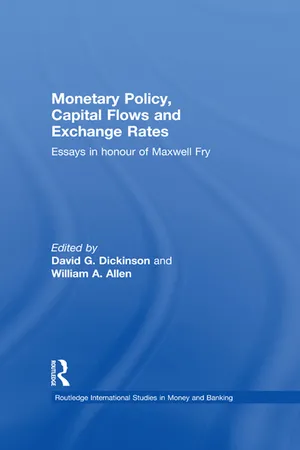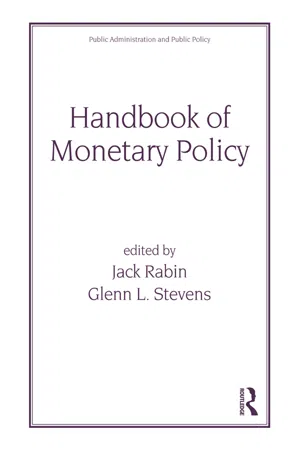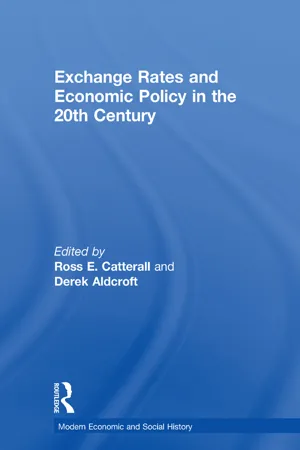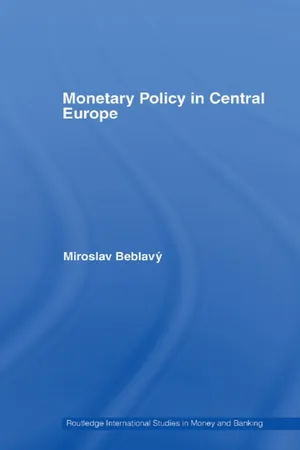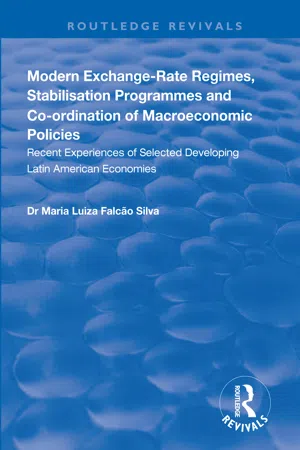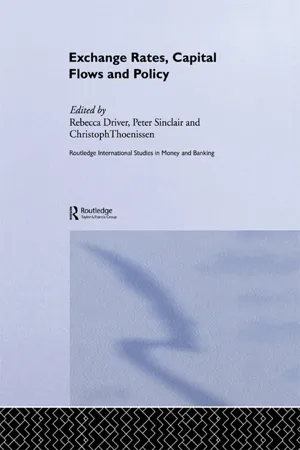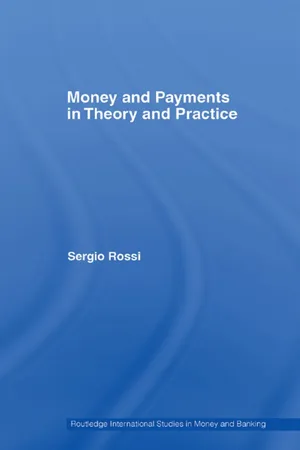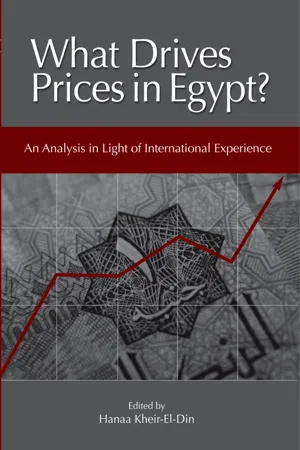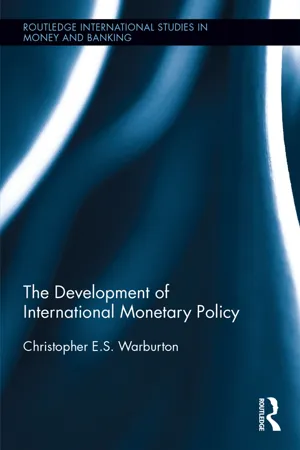Economics
Exchange Rate Targeting
Exchange rate targeting is a monetary policy strategy where a central bank aims to maintain a specific value for its currency in relation to another currency or a basket of currencies. This is achieved by buying or selling its own currency in the foreign exchange market. The goal is to stabilize exchange rates and promote economic stability.
Written by Perlego with AI-assistance
Related key terms
10 Key excerpts on "Exchange Rate Targeting"
- William Allen, David Dickinson(Authors)
- 2002(Publication Date)
- Routledge(Publisher)
2The differences between inflation targeting and Exchange Rate Targeting are greater, both in concept and in practice, than the differences between inflation targeting and monetary targeting. Of course, it is true that Exchange Rate Targeting makes sense only if there is a predictable relationship between the exchange rate and future inflation, just as in the case of monetary targeting. But not every country can pursue an exchange rate target, for obvious reasons. Somewhere there has to be a so-called anchor currency country which sets a standard by using a different monetary policy technique – and in an important sense countries which target their exchange rates against the anchor currency are borrowing that country’s monetary policy technique and its monetary policy credibility. And, while it is possible to depart temporarily from monetary targets if the underlying relationships appear to have changed,3 it is generally not possible to depart temporarily from exchange rate target bands without there being a severe loss of credibility.Specification of the Inflation TargetIt is easy to say that the objective of monetary policy is price stability. It is much harder to specify what that means in terms of observable quantities. A number of decisions need to be made in setting an inflation target. They include:- What price index, and at what level should the target be set?
- Should there be a target band, and if so, how wide should it be?
The measurement of inflation is an important subject in its own right, irrespective of the choice of monetary policy technique. The use of inflation targets merely makes its importance more obvious. Although measurement issues may appear to be matters of detail, they nevertheless raise some fundamental questions, two of which are discussed below.- eBook - ePub
- Jack Rabin(Author)
- 2020(Publication Date)
- Routledge(Publisher)
During the 1980s and 1990s, a number of countries abandoned these more traditional anchors. One reason was that the relationship of monetary aggregates to economic activity broke down in many countries, leaving those central banks that targeted monetary aggregates relying more on discretion and looking at a wide range of information for guidance. With most of these central banks using a very short-term nominal interest rate as the instrument of monetary policy, some analysts became concerned that, without an explicit target, monetary policy could develop an inflationary bias. For example, if policymakers were slow to react to rising inflation expectations, short-run real interest rates would fall, leading to an increasingly accommodative policy at a time when policy might need to be tightened.Other countries that used exchange rate targets abandoned them when exchange rates became misaligned. The problem with using exchange rates as targets is that monetary policy must be directed at keeping the exchange rate within its target range, sometimes at the expense of promoting favorable domestic macroeconomic performance. If exchange rate targets are consistent with favorable macroeconomic performance, they can work well as an anchor for policy. When exchange rates become misaligned, however, a central bank may find itself defending the foreign exchange value of its currency at the cost of achieving goals for the domestic economy. When this happens, speculators may attack the currency, leading possibly to a realignment of exchange rate targets or, at the extreme, their demise as a guide to monetary policy. An example of this phenomenon occurred in the United Kingdom during the crisis in Europe’s exchange rate mechanism (ERM) in 1992, when the UK left the ERM and established inflation targets as its anchor for monetary policy.Improving Transparency and Accountability
Another rationale for inflation targets is that they can improve the transparency of monetary policy and the accountability of monetary policymakers. Inflation targets are highly transparent because they convey to the public a precise, readily understood goal for monetary policy. For example, an inflation target under which a central bank commits to “keep increases in the consumer price index between 1 and 3 percent annually from now until the end of the year 2001” gives the public a clear signal of both near-term and longer term plans. A central bank with such a target provides a clearer signal than a bank that simply commits to “achieving price stability in the long run,” without specifying a numerical definition of price stability or a time frame for achieving it. Of course, the more precise a target, the easier it is to tell whether a target is hit or missed. And when targets are missed, policymakers have to explain why. Advocates of inflation targeting argue that explaining target misses increases transparency. Critics contend that inflation targets might give policymakers too strong an incentive to hit the target at the expense of adverse short-run fluctuations in output and employment.3 - Derek H. Aldcroft, Ross E. Catterall(Authors)
- 2017(Publication Date)
- Routledge(Publisher)
The use of an exchange rate target eliminates the trade-off between controllability and visibility which exists with an inflation target or a money supply target. The exchange rate target is fully controllable (provided that there are sufficient foreign exchange reserves) and highly visible. However, an exchange rate anchor creates other trade-offs, for example in the area of the balance of payments, and there is a loss of independent monetary policy.While inflation targets are at present in vogue with several monetary authorities, not all countries need to have this framework for the successful conduct of monetary policy (exceptions include Germany and the USA). In countries where the credibility of monetary policy is in question, and the reputation of the central bank poor, inflation targeting has controlled the growth of inflation. In the long run, however, the single most important element in any anti-inflation strategy is the degree of commitment of the central bank to achieve low inflation. The jury is still out on whether inflation targets can deliver low inflation over longer time periods, and whether central banks are prepared to persevere with this technique.References
Allen, W.A. (1999), Inflation Targeting: The British Experience, London: Bank of England.Bank of England (1971), ‘Monetary Management in the United Kingdom’, Bank of England Quarterly Bulletin, 11.Clarida, R. and M. Gertler (1997), ‘How the Bundesbank Conducts Monetary Policy’, in Christina D. Romer and David H. Romer (eds), Reducing Inflation: Motivation and Strategy, Chicago, IL: University of Chicago Press.Commission of the European Communities (1970), ‘A Plan for the Phased Establishment of an Economic and Monetary Union’, Bulletin of the European Communities (supplement), 3.Commission of the European Communities (1989), Report on Economic and Monetary Union in the European Community, Luxembourg: Office for Official Publications of the European Communities.Crockett, A. (1994), ‘Rules versus Discretion in Monetary Policy’, in J. Onno de Beaufort Wijnholds, Sylvester C.W. Eijffinger and Lex H. Hoogduin (eds), A Framework for Monetary Stability- eBook - ePub
- Miroslav Beblavý(Author)
- 2007(Publication Date)
- Routledge(Publisher)
Whenever monetary targets were used in Central Europe, they stood alongside Exchange Rate Targeting in the form of a fixed exchange rate. (The only exceptions are short periods in the Czech Republic and Slovakia following the demise of their pegs.) The monetary targets were also important for central banks in their decision-making. While fixed exchange rates provided nominal anchors for outsiders, they provided little guidance for policy-makers themselves on how to set policy instruments to make the exchange rate sustainable or to achieve a targeted level of inflation. In this sense, monetary targets can be seen as a true intermediate target – a variable influencing inflation that the central bank could control. However, this proved to be the case only with high inflation and low capital inflows. Once inflation dipped below 20 per cent and net capital flows became important in comparison with the overall money supply, monetary targeting became a blunt instrument indeed.On a similar note, a rapid capital outflow had a substantial dampening effect on monetary growth often without a corresponding effect on inflation, as inflation was more influenced by currency depreciation and increased inflation expectations (as evidenced by the Czech and Slovak experience in 1997 and 1998).After the Exchange Rate Targeting was terminated either voluntarily or following a crisis, all four countries gradually shifted towards inflation targeting. In such an environment, setting and announcing monetary targets became much less relevant and the practice was discontinued.Inflation targeting – introduction
Inflation targeting dispenses with a formal intermediate target and attempts to target inflation directly. The boundary between inflation targeting and other monetary policy frameworks (such as money targeting and discretionary policy with an implicit anchor) is highly uncertain and frequently in the eye of the beholder (Mishkin and Savastano 2001).After several developed economies – e.g. Canada, New Zealand, United Kingdom, Sweden, Spain, Finland and Australia – adopted inflation targeting in the early to mid-1990s and early evaluations indicated the relative merits of the new framework (Almeida and Goodhart 1998; Brunila and Lahdenpera 1995; and Leiderman and Svensson 1995), it was rapidly instituted by many developing and transitional economies, which either voluntarily or under duress gave up their fixed exchange rate. Brazil, the Czech Republic, Hungary, Israel, Mexico and Poland are among developing or transitional economies that recently switched to inflation targeting (e.g. Bogdanski et al. - eBook - ePub
Modern Exchange-rate Regimes, Stabilisation Programmes and Co-ordination of Macroeconomic Policies
Recent Experiences of Selected Developing Latin American Economies
- Maria Luiza Falcão Silva(Author)
- 2018(Publication Date)
- Routledge(Publisher)
vs . Exchange-Rate Targeting Revisiting the Rules vs. Discretion DebateIntroduction
Chronic high inflation is a symptom of policy instability, and has frequently been associated with policy uncertainty. Therefore, in large parts of the developing world, Latin America, for instance, macroeconomic instability has been endemic.The steps different governments take to stop hyperinflation processes are embodied in stabilisation programmes or strategies. The successive failures of policies to control price rises in most Latin American countries, suggest that ending inflation is a complex task. Recent developments in the literature have highlighted the role of credibility and its interactions with expectations regarding the sustainability and political feasibility of government stabilisation policies. In this line of reasoning it has been argued that the success of stabilisation programmes “much depends on the credibility of the government, that is, the public’s belief that budget deficits and monetary growth are really going to stop” (Gordon, 1993, p.304). However, the combination of stabilisation strategies is very broad. Some successful stabilisation programmes are, for example, Israel, Chile and Mexico (until 20 December, 1994 - the day Mexico devalued its currency with strong spill over effects- the tequila effect 1 - throughout the whole region).Recently, in the economic literature, the old controversy dealing with the role of exchange-rate policy in macroeconomic adjustment processes, has been revived. The use of the exchange rate as a policy instrument to stabilise prices, particularly in developing countries, has been subject to much debate. A variety of arguments have been proposed favouring the adoption of fixed exchange-rate arrangements. The focus is on the role of the exchange rate as an anchor in the context of disinflation programmes. The ‘credibility effect’ that a fixed rate may attach to these programmes is one of the strongest arguments presented. The idea is that: - eBook - ePub
- Rebecca Driver, Peter J N Sinclair, Christoph Thoenissen(Authors)
- 2013(Publication Date)
- Routledge(Publisher)
3Exchange rates, inflation and monetary policy objectives in open economiesThe experience of Chile
Rodrigo Caputo 11 Introduction
Inflation targeting was adopted by Chile in 1990. In practice, this means that every year the Chilean Central Bank (CCB) announced the inflation target,2 and then it made use of the monetary instruments (interest rate) to fulfill this objective. Some other objectives, like controlling the real exchange rate or avoiding excessive fluctuations in the output level were not explicit objectives of the CCB.There is some evidence, however, that central banks in emerging economies use the interest rate to avoid exchange rate fluctuations. In fact, Calvo and Reinhart (2002), concluded that in some countries interest rate and exchange rate move in the same direction; depreciations in the exchange rate (domestic price of foreign currency) generate an increase in the interest rate controlled by the central bank. Furthermore, they argue that interest rate policy is replacing foreign exchange intervention as the preferred means of smoothing exchange rate fluctuations. According to this view monetary authorities try to stabilize the exchange rate, even if they claim to have a flexible exchange rate system.Another reason why a central bank may react to real exchange rate, independently of its impact on future inflation, is that in this way it can improve macroeconomic performance. In fact, some simulations reported by Cecchetti et al . (2000), suggest that responding to exchange rate shocks over and above the effect of such a shock on the central bank’s inflation forecast appears to be welfare-improving.3 In a different study, Batini et al - eBook - ePub
- Sergio Rossi(Author)
- 2007(Publication Date)
- Routledge(Publisher)
5 Monetary policy strategies
Monetary policy strategies around the world are increasingly centred on attaining some targeted rate of inflation, which several academics and policy makers assimilate to price level stability when the measured inflation rate is around but below 2 per cent (owing to a number of measurement biases, as reviewed by Rossi (2001: 31–41)). As a matter of fact, targeting inflation has become a fashion. Since the Reserve Bank of New Zealand first adopted this monetary policy strategy in 1990, an increasing number of monetary authorities around the world – first in advanced economies only, later also in developing and emerging market economies – have been abandoning their monetary or Exchange Rate Targeting strategy to follow this new fashion. As with several fashions nevertheless, targeting an inflation rate rather than an exchange rate or a growth rate of a monetary aggregate has been adopted without any fully thought-out analytical investigation of a phenomenon as complex and controversial as inflation. The same may be argued with respect to previous monetary policy strategies, as they all stem from a symptom-based perception of inflation.It is indeed both undisputed and undisputable today that ‘[e]conomists’ perceptions of inflation rest on measurements of the “general price level” and on rates of change of price indexes’ (Gale 1981: 2). In fact, as surveys of inflation theories show, neither a satisfactory nor an exact analytical definition of inflation exists as yet in the literature (see Bronfenbrenner and Holzman 1963, Laidler and Parkin 1975, Frisch 1983, Parkin 1987, McCallum 1990). This is so much so that, to date, the phenomenon of inflation has been grasped merely by considering its most evident symptom, namely the increase of the relevant consumer price index (or some core inflation index), with no analytical thought whatsoever as to its underlying cause. - eBook - ePub
What Drives Prices in Egypt?
An Analysis in Light of International Experience
- Hanaa Kheir-El-Din(Author)
- 2009(Publication Date)
- The American University in Cairo Press(Publisher)
CHAPTER 4 Monetary Policy in Egypt:A Retrospective and Preparednessfor Inflation TargetingRania Al-Mashat1I nflation targeting (IT) is one of the operational frameworks for monetary policy aimed at attaining price stability. In contrast to alternative strategies, notably money or Exchange Rate Targeting, which seek to achieve low and stable inflation through targeting intermediate variables—for example, the growth rate of money aggregates or the level of the exchange rate of an ‘anchor’ currency—IT involves targeting inflation directly (World Economic Outlook 2005). In a wider context, IT is part of a process in which economic policymaking is becoming more transparent and subject to greater accountability and technical rules, and less susceptible to discretionary actions.IT has become an increasingly popular monetary policy strategy, with around twenty-one countries, eight industrial and thirteen emerging markets, now inflation targeters. Other countries are seeking to develop the necessary ‘infrastructure’ to implement an IT framework, Egypt being one of the forerunners. However, the technical details related to the adoption of IT are not trivial, and there are several country-specific factors that need to be taken into consideration.Since June 2005, the Central Bank of Egypt (CBE) has taken serious steps to develop its monetary policy framework with the intention of adopting IT over the medium term. The exchange rate has been abandoned as the nominal anchor, and price stability has been declared the overriding policy objective. Key institutional and operational steps have been implemented in the transition.Against this background, empirical research on monetary policy in Egypt has recently come to the forefront as researchers try to investigate the inflation process and reconcile the requirements of IT with economic realities.This chapter attempts to accomplish two tasks. First, it provides a retrospective overview of monetary policy instruments used in Egypt between 1996 and 2005 in an effort to explain the decision-making process. To address this, a parsimonious empirical estimation is conducted to investigate the relationship between monetary aggregates and inflation. Second, the chapter discusses the preparedness of the CBE to adopt an IT framework, in light of the new monetary policy framework launched in 2005 and in comparison to other emerging country cases. - eBook - ePub
- Christopher Warburton(Author)
- 2017(Publication Date)
- Routledge(Publisher)
6 Exchange rates as monetary policy toolInternational trade and monetary policy are inextricably linked through the exchange rate and net exports channels. While it has been a traditional policy to use the money supply and interest rate to stabilise economies, the exchange rate could also be used to obtain some measure of price stability and sustainable economic growth. The literature reflects that Singapore has embarked on such a policy with reasonable successes since 1981.Singapore has demonstrated that for a small open economy with substantial capital flows, the exchange rate can be used as an intermediate target of monetary policy. Intervention in the foreign exchange market is carried out with price stability as the ultimate medium term (six months) target. The Monetary Authority of Singapore (MAS) uses four main mechanisms to achieve its stabilisation objectives by exchange rate adjustments: (i) the domestic currency (Singapore dollar) is managed against a basket of currencies owned by major trading partners and competitors; (ii) the MAS operates a managed float (the trade-weighted rate is allowed to fluctuate within a policy band);1 (iii) the exchange rate policy band is periodically reviewed to ensure that it remains consistent with the underlying fundamentals of the economy to avoid misalignment in the value of the currency;2 and (iv) the MAS uses exchange rates in lieu of money supply and interest rates as monetary policy.Notably, the exchange rate has been an effective anti-inflation tool for the Singapore economy. Over the past twenty years or so (since the exchange rate framework has been in place), domestic inflation has been relatively low, averaging 1.9 percent per annum from 1981 to 2010.3 - eBook - ePub
Exchange Rate Economics
Theories and Evidence
- Ronald MacDonald(Author)
- 2007(Publication Date)
- Routledge(Publisher)
12 The economics of fixed exchange rates, part 1 Target zone modelsSo far in this book we have considered the determination of exchange rates when the exchange rate is freely floating. We now turn to the determination of exchange rates when exchange rates are fixed. It may seem odd to consider the determination of a price which is fixed, however, as Svensson and others have argued there is really no such thing as a truly fixed exchange rate (monetary unions aside). If we take the Classical Gold Standard period, in which participating currencies were fixed to each other because they first of all fixed their currency in terms of gold, there was nonetheless some exchange rate flexibility because of the costs of shipping gold between countries and certain opportunity costs (such as the funds tied in shipping gold). These costs set-up bands above and below the central parity which are referred to as a target zone. Admittedly, such bands were very narrow, but nonetheless some have argued (see, for example, Svensson 1994 and Bordo and MacDonald 2005) that they conferred on the government of the day some autonomy in the operation of its monetary policy (we consider this point in more detail later). The existence of target zones in other fixed rate regimes is perhaps clearer since such regimes have explicit bands above and below the central parity (in the Bretton Woods regime currencies were allowed to float by plus or minus 1% relative to the central rate, while in the ERM of the EMS the bands ranged from plus or minus 2.5% to plus or minus 15%). How then are exchange rates determined within such bands?As Krugman (1991) notes, a naive interpretation of how exchange rates likely behave within a band would be to say that they behave like flexible rates until they hit the edge of the band, whereupon the regime switches to a fixed exchange rate. However, such an interpretation is not correct since the existence of the bands constrains the future behaviour of the exchange rate and if agents are forward-looking this should affect the behaviour of the exchange rate within the band. Expectations formation is therefore a crucial aspect of the determination of target zone exchange rates.
Index pages curate the most relevant extracts from our library of academic textbooks. They’ve been created using an in-house natural language model (NLM), each adding context and meaning to key research topics.
